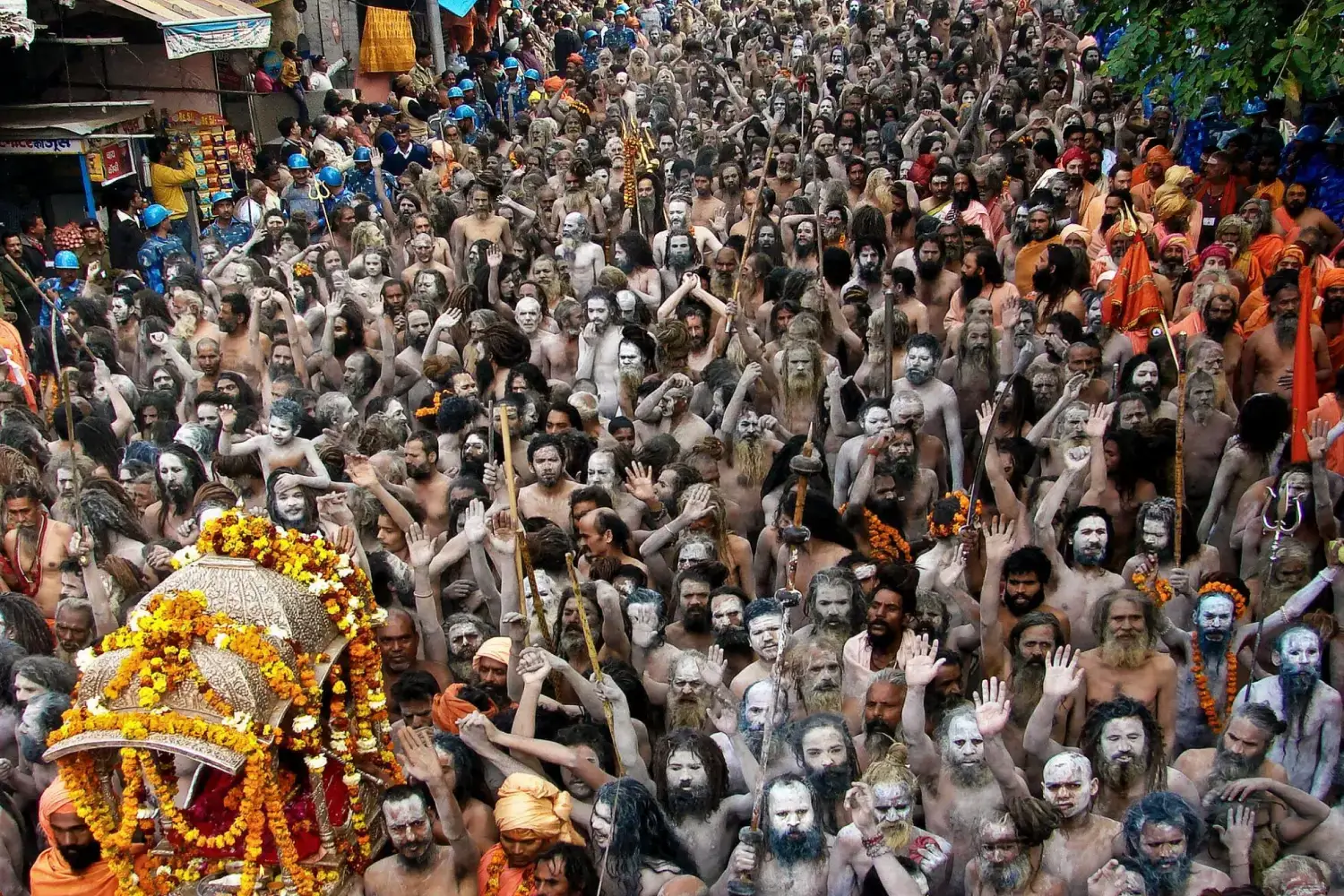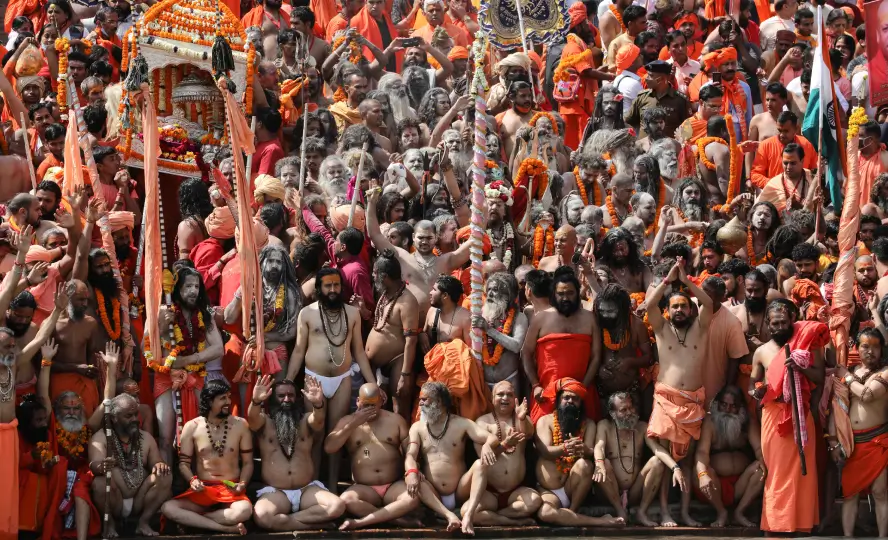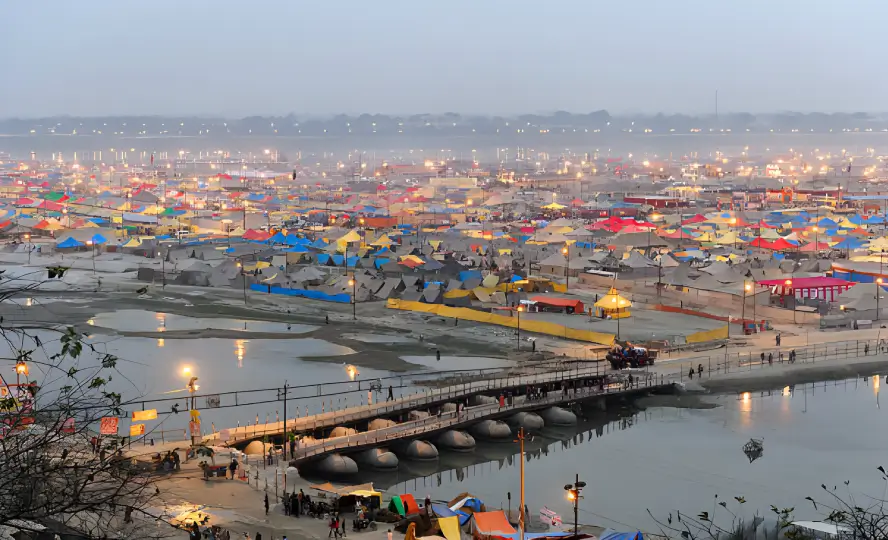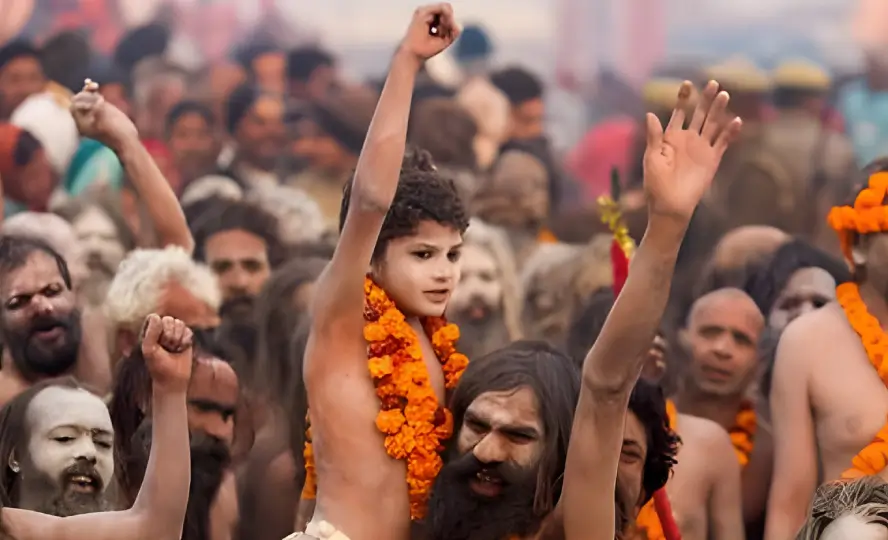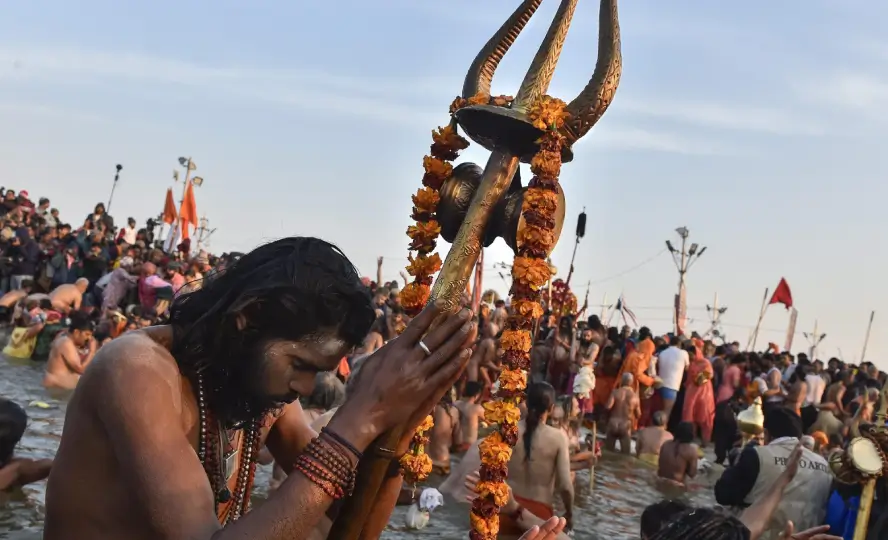Kumbh Mela – The Largest Spiritual Gatherings in India
Learn detailed information about the origin and history of Kumbh Mela, its significance in Hinduism, the different types of Kumbh Mela, Kumbh Mela destinations, and the upcoming Haridwar Kumbh Mela 2027, including the important bathing dates.
Tourists coming to the land of India often wonder with a question ‘What is the Kumbh Mela?’ To get the answer it is important to remember that India is a diverse country that celebrates every festival with great enthusiasm and supports every religion wholeheartedly. Kumbh Mela is one such festival among Hindus that is celebrated four times over the course of 12 years at four different pilgrimage sites. The festival of Maha Kumbh Mela is said to arrange the largest congregation of Hindu pilgrims on earth where they take a dip and bathe in the sacred rivers to get rid of their sins. The gathering consists of ascetics, saints, sadhus, aspirants-kalpavasis, and tourists who reach the place out of devotion and search for life secrets.
Devotees come to visit the four holy destinations which are Allahabad, Haridwar, Ujjain and Nashik depending upon every four years rotation. Millions of people irrespective of their gender, colour, caste or creed visit to take a bath in holy water to liberate themselves from the cycle of birth and death. People believe that speculating the event is a once in a lifetime experience as the ritual bathing in the holy water is drenched with fragrance of flowers and incense while following the enchantment of Vedas, hymns & mantras.
The renowned Kumbh Mela which receives millions of visitors each time got much deserved recognition as it was added to UNESCO's List of Intangible Cultural Heritage in 2017 to honour the spiritual minds and countrymen of India. The festival of Kumbh Mela in India has been the world's biggest harmonic assembly as it represents characteristics such as magnanimity and patience, which are extremely useful to modern mankind. Furthermore, the notion of Kumbha Mela aligns nicely with contemporary international human rights tools since the celebration invites people from all over the world without discrimination. The event also continues the lineage of teachers and students as skills from saints and sages are transferred to their disciples.
Historical, Spiritual & Religious Significance
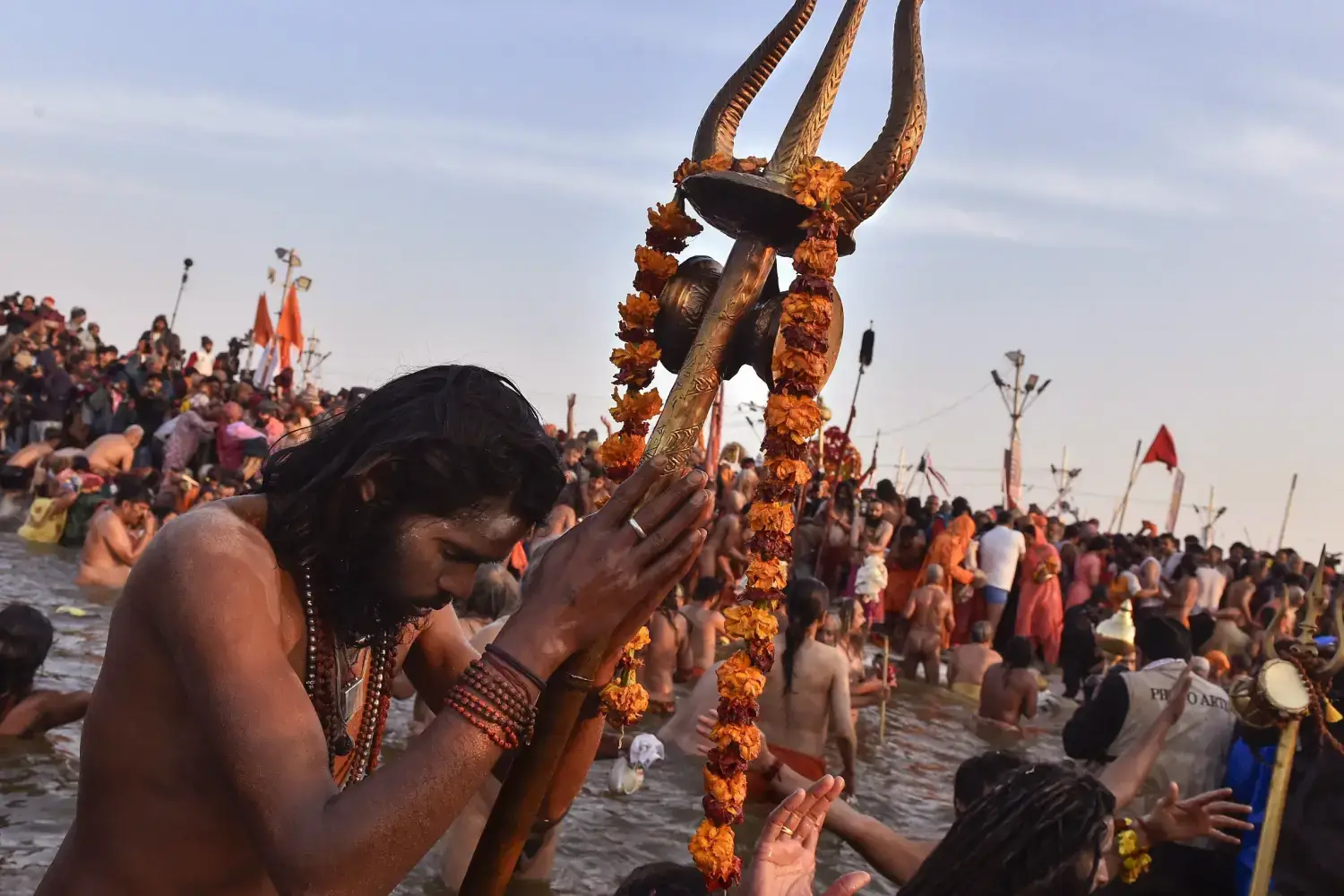
Kumbh Mela Pilgrimage is one of the important pilgrimages among the Hindu community as they believe taking a holy dip in the sacred rivers of Haridwar, Prayag (Allahabad), Ujjain and Trimbak-Nashik will help them wash away their sins and darkness. The pilgrims get the chance to fill their souls with the essence of purity and optimism. The reference to the Kumbh Mela was found in the diaries of a famous ancient Chinese traveller, Huan-Tsang. He mentioned that Kumbh is a 75 day festival held in the month of Magha (January - February) and is attended by millions of saints, kings and Hindu pilgrims.
According to mythological books and tales, the history of Kumbh Mela originated with the 8th-century philosopher Adi Shankara, who organised periodical meetings of scholarly believers for discussion and debate. The Kumbh Mela is widely mentioned in the books of Hindu mythology when the earth used to be the dwelling place for the gods and during that period, a churning of oceans (Samudra Manthan) happened, the nectar of immortality (Amrit) came up, demons started a fight with the gods to get hold of it but couldn’t because Lord Vishnu went away with the pot (Kumbh). Between all this, he dropped four drops of the liquid at four different places on earth which came to be known as the four holy destinations of Kumbh Mela.
The word Kumbh means ‘Kalash’ (pot) which has great significance in Hindu civilization and customs. Kumbh signifies a source of energy which unifies nature and humanity. Not only is the term Kumbh derived from this legendary elixir pot, but it is also the Hindi name for Aquarius, the sign of the zodiac in which Jupiter resides on the occasion of Haridwar Mela. The celebration in each location is centred around an exceptional combination of Sun, Moon, and Jupiter astrological positions; the holiest period falls at the precise moment when these positions are completely filled.
Kumbh Mela is a key spiritual event in the country, with a mesmeric effect on ordinary Indians. The event encompasses the science of astrophysics, astrology, faith, ceremonial traditions, and social and cultural norms and practices, making it exceedingly rich in knowledge. Oral traditions, historical travelogues, old religious writings, and books written by renowned historians are all used to teach knowledge and skills about the tradition. The sadhus' teacher-student connection at ashrams and akhadas, however, continues to be the most significant means of spreading and preserving knowledge and skills related to Kumbh Mela.
Types of Kumbh Mela
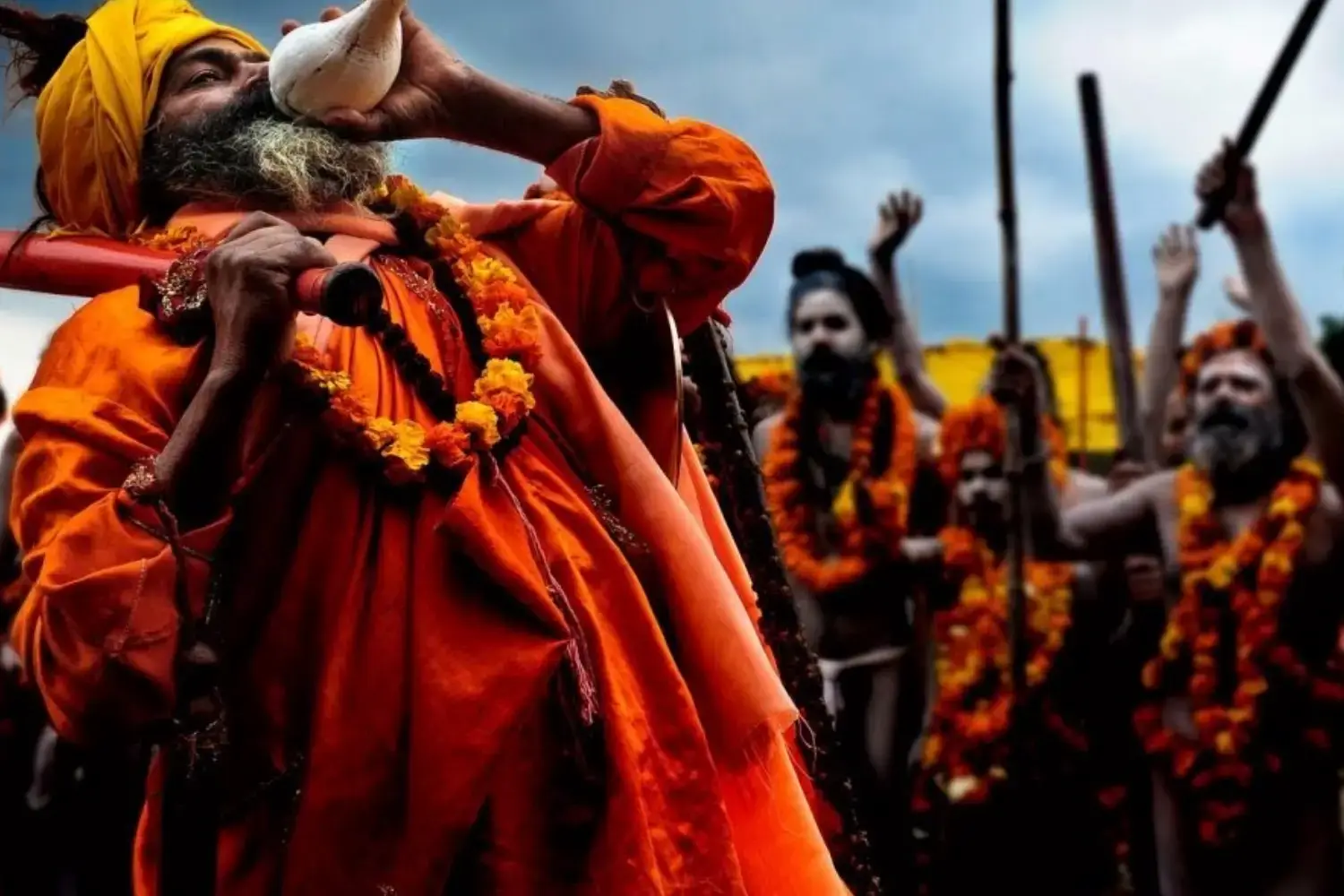
The festival of Kumbh Mela which is organised at four holy sites in India is categorised into 5 different types. Being a popular festival among Hindus, every type of the Kumbh festival has its own significance. The four types of Kumbh Mela organised in India are stated below:
Maha Kumbh Mela - The Maha Kumbh Mela which happens every 144 years or after 12 Purna Kumbh Mela is held only in Prayagraj (Allahabad) making the location the holiest among others. People who get to witness the Maha Kumbh Mela in their lifetime are believed to be the luckiest. Maha Kumbh Mela of Prayag lasts for several weeks and keeps attracting millions of people each time.
Purna Kumbh Mela - The Purna Kumbh Mela is held in all 4 holy destinations of India i.e. Allahabad, Haridwar, Nasik, and Ujjain. The event of Purna Kumbh Mela keeps rotating every 12 years in these 4 places.
Ardh Kumbh Mela - The Ardh Kumbh Mela is also known as Half Kumbh which specifically means half of 12 years. The Ardh Kumbh Mela is held every 6 years in only two holy destinations, Haridwar and Prayagraj.
Magh Kumbh Mela - The Magh Kumbh Mela also known as Mini Kumbh is organised every year in Prayagraj (Allahabad). The event occurs in the month of Magh month of the Hindu calendar which means mid-Jan to Feb end. According to mythological tales, the Magh Mela is said to be the starting point of the Universe as it takes place on the confluence of 3 holy rivers called Triveni Sangam. The important bathing dates of Magh Mela are spread over a period of 45 days and pilgrims take a holy dip at the Sangam on the auspicious dates.
Kumbh Mela Location
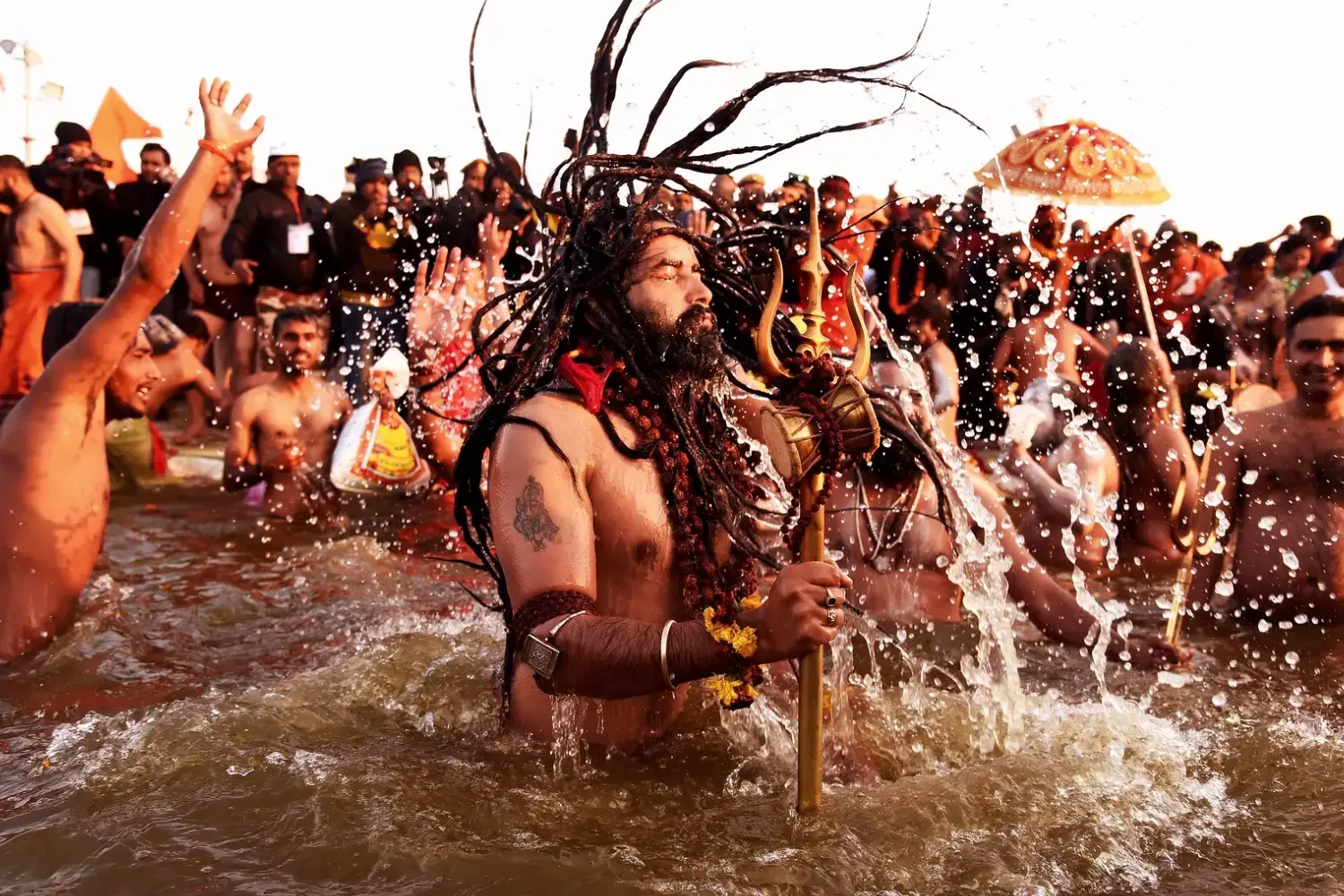
The River Ganga is said to be the mother of all festivals in India and all other rivers are like her child. The festival of Kumbh Mela is connected to the auspicious rivers of the nation of four different locations as stated below:
- Haridwar on the Ganges River in Uttarakhand.
- Ujjain on the Shipra River in Madhya Pradesh.
- Nashik on the Godavari River in Maharashtra.
- Prayag (modern Prayagraj) at the confluence of rivers Ganges, Yamuna, and Sarasvati in Uttar Pradesh.
Key Rituals and Activities in Kumbh Mela
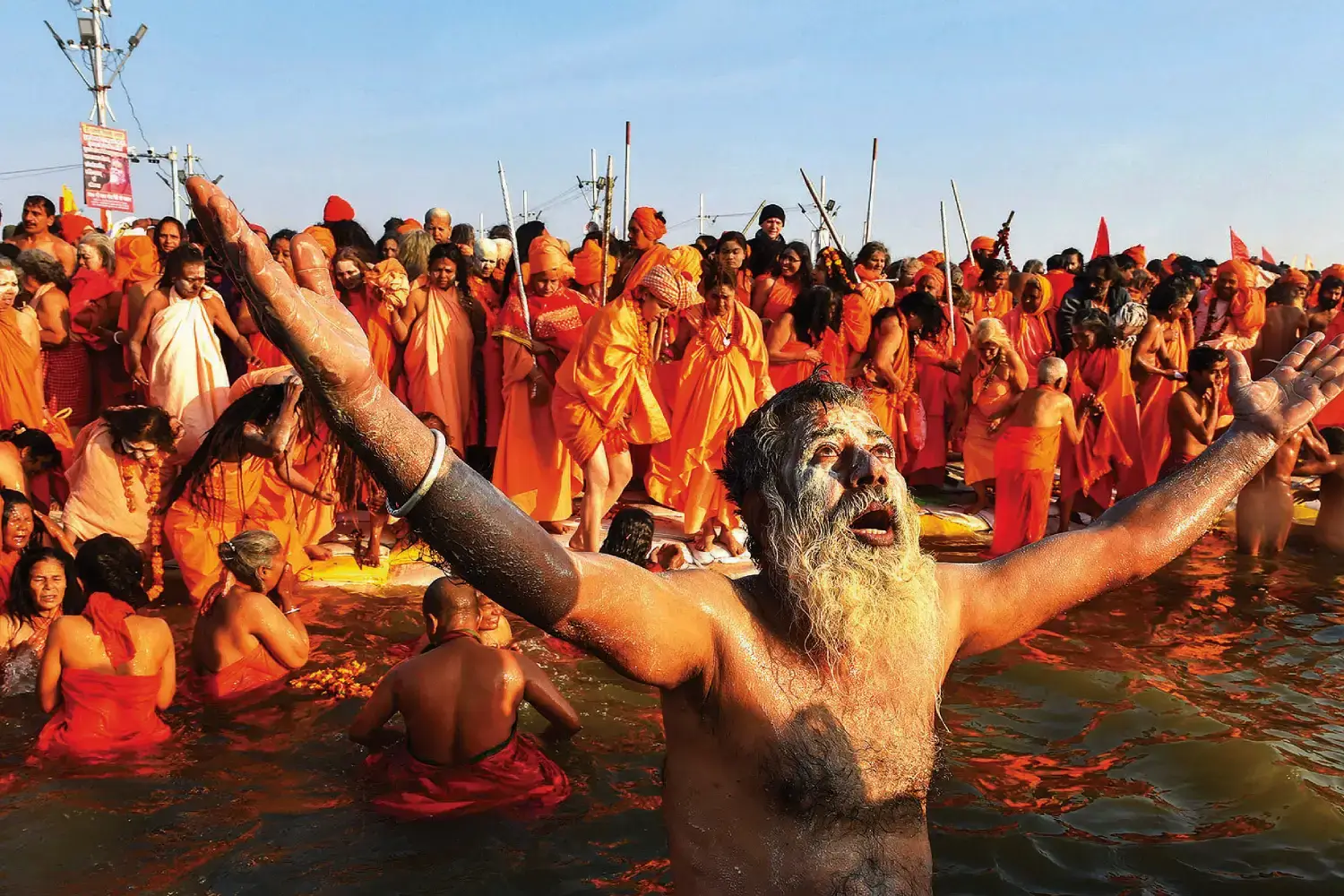
The Kumbh Mela takes place at four different holy sites of India after an interval of every 4 years near the holy rivers named Ganga, Yamuna, Saraswati, Shipra and the Godavari. During the auspicious festivals, many fairs and ceremonies are held which include traditional processions. The customary parade involving Akharas, known as Peshwai come riding on horses, chariots, and elephant backs, the display of gleaming swords, and Naga Sadhus' rites during the Shahi Snan are all represented during Kumbh Mela.
The significance of Kumbh Mela stems from the fact that it brings together a variety of aspects, including the convergence of all civilizations, spirituality, humanity, rituals, customs, the essence of life, and binding forces because of its four different locations. The rituals and activities that are performed during the festival are mentioned below:
Aarti
The concept of Aarti in Hindu tradition has great importance as humans show their respect, devotion and faith towards the holy rivers by doing grand arrangements and chanting of hymns and mantras. Thousands of people become spectators and participate with tremendous gratitude during the Arati ritual. Aartis at the riverbanks are usually performed by the Batuks (priests) holding huge lamps two times a day, especially in the mornings and evenings.
Kalpavas
Kalpavas have a huge spiritual and cultural significance among Hindus and it means devotees reside for an entire month near the banks of the sacred rivers. The word ‘Kalpavas’ is derived from the Sanskrit word, where ‘Kalp’ means long period and ‘Vas’ means to live. Doing Kalpavas at the confluence of rivers is considered to be quite sacred as it involves around a set of 21 rules that are followed like celibacy, honesty, nonviolence, sacrifice of all worldly pleasures, and a comprehensive list of Brahmachari principles. The Kalpvas period lasts from the Ekadashi of the full moon in the Magh month of the Hindu calendar to the Maghi Ekadashi, which is equivalent to January-February in the Gregorian calendar.
Deep Daan
Deep Daan is one of the most fascinating panoramas of Kumbh Mela where people offer earthen lamps (diyas) in sacred rivers, forests, temples and other holy sites to spread purity and spirituality in the environment.
Snan
The concept of snan (bath) in holy water is performed before starting any auspicious work, therefore a significant ritual bath also takes place at the Kumbh site. Devotees believe that taking a bath or dip in the holy river of the Kumbh sites will help attain Moksha as they get themselves relieved from the cycle of birth and death. Washing away all the sins and darkness will give them a sense of purity within their souls. Many rituals and pujas are also performed at the river banks with the help of priests.
Huge gatherings of saints, their followers and members of Akharas take part in the Shahi Snan which is also known as the Rajyogi Sean before participating in the rituals and other activities of Kumbh. It is believed that taking holy dips every day in the river is quite auspicious and purifies one's soul.
Satsangs
During the Kumbh Mela, the satsang is a fundamental part of the festival which attracts millions of people to listen to the religious hymns, mantras and prayers for quite long hours. Saints and devotees with deep devotion inside themselves can be easily seen reciting spiritual chants which cleanse the mind and soul.
Parikrama
Parikramas (circumambulation) of the four sites with the changing times have a great impact on devotees. Parikramas have always remained an important factor of Kumbh since the beginning of the festival.
About Kumbh Mela 2027: What to Expect
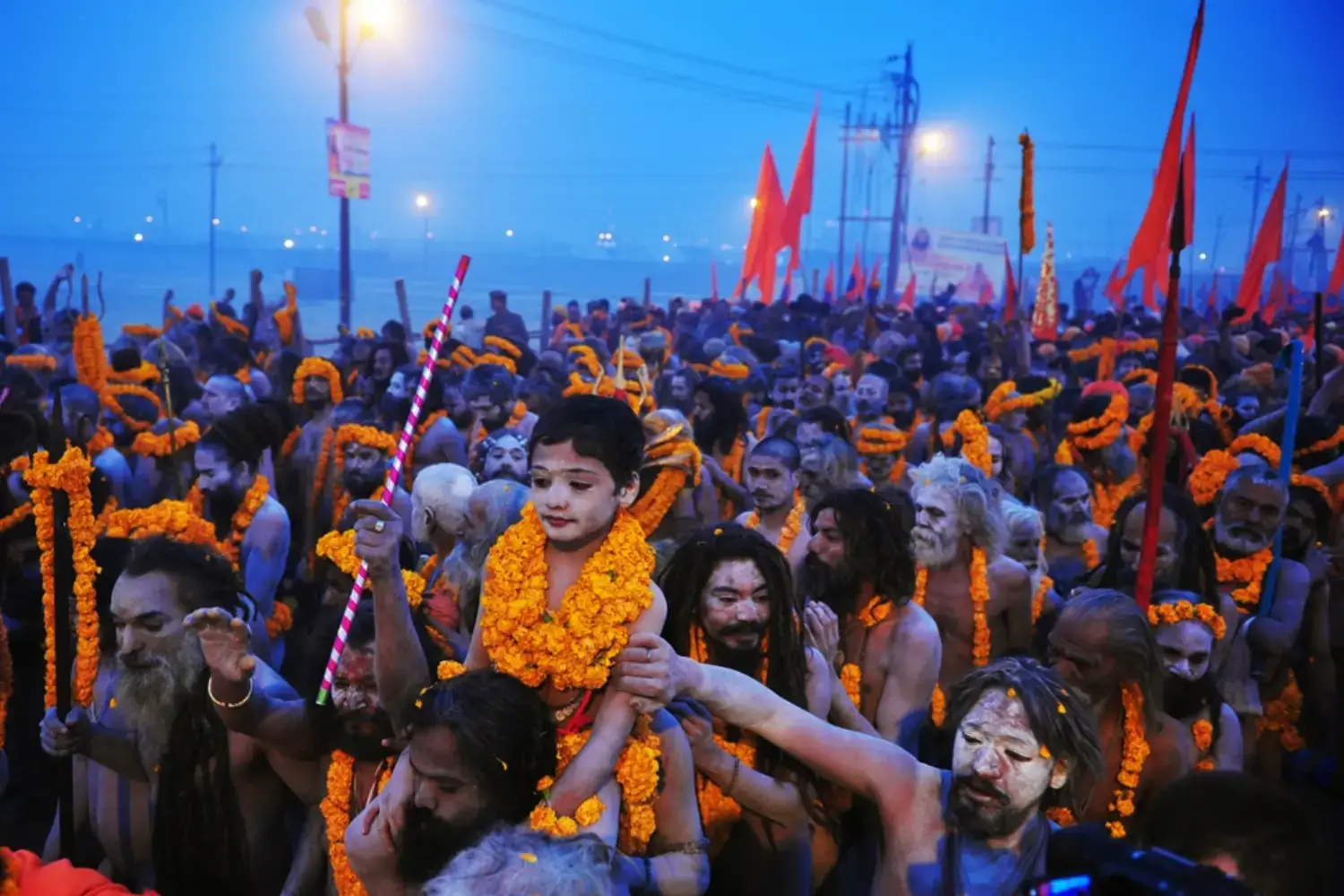
Since many decades have passed, Hindus are seen visiting different pilgrimage sites to sanctify their souls and hence visiting the upcoming Haridwar Kumbh Mela 2027 will be a great event for them. The major event is happening in the Haridwar of Uttarakhand where it is expected that a huge gathering of people will take place again. More than 2 crores are expected in Kumbh Mela 2027 to reach the city of Haridwar to perform the holy bath at the Harki Pauri Ghat.
People also believe that according to the positioning of the stars and planets during Kumbh, the river waters turn into Elixir (Amrit) where the Hindu pilgrims take a dip to wash away their sins. Not only people from different states of India but tourists from abroad nations are also expected to join the gathering of Kumbh Mela according to data covered so far. It is also suggested that to attend the event without any hassle, book flight and train tickets a little faster.
Many official arrangements such as security, sanitation, accommodation centres, civic facilities and broadening of roads have been made and the work is still in progress to expect a smooth functioning during the Kumbh Mela 2027. As suggested by the state government, the police and other public service departments are making up special teams to manage the huge gathering efficiently.
Haridwar Kumbh Mela 2027 - Bathing Dates

Every six years, Haridwar celebrates Ardh Kumbh Mela in the months of January and February when the planets and stars come in a specific zodiac position during the Hindu month of Magh. The Kumbh Mela bathing dates in 2027 are beginning on January 14, 2027 and ending on April 20, 2027. It will once again be the focus of global fascination and attention.
Important Bathing Dates
- 14 January – Makar Sankranti
- 06 February – Mauni Amavasya
- 11 February – Vasant Panchami
- 20 February – Magh Purnima
- 06 March – Amrit Snan (Mahashivratri)
- 08 March – Amrit Snan (Falgun Amavasya)
- 07 April – Nav Samvatsar
- 14 April – Amrit Snan (Mesh Sankranti)
- 15 April – Shri Ram Navami
- 20 April – Chaitra Purnima
Interesting Facts
- The worldwide famous Kumbh Mela was added to the list of Intangible Cultural Heritage in 2017.
- Till now as per Government data, a record was set in 2019 as around 24 million people visited the Sangam city including 1 million foreign tourists.
- The slogan for Kumbh Mela 2027 - Chalo Kumbh Chalo-Chalo Kumbh Chalo (Let’s go Kumbh – come on Kumbh).
- The Shaivanti Naga Sadhus are typically a popular attraction of every Kumbh fair.
Following all the ethics, culture and rituals of the Kumbh Mela, it is noticed that the event stands as a testament to the enduring power of faith and unity among Hindus and even foreigners. Millions of people irrespective of their sex, caste, culture and creed come together to celebrate the grand festival and seek blessings from the sacred rivers.
The glorious festival finely blends the cultural and spiritual heritage with peace and harmony. Experiencing some wonderful rituals and sacred activities by sacred rivers is undoubtedly a once-in-a-lifetime opportunity that one should not pass up. Ultimately, the Kumbh Mela is more than simply a pilgrimage; it is a celebration of life, a path towards spiritual enlightenment, and a powerful representation of humanity's shared soul.
You Might Also Like to Read
- The History of Kumbh Mela
- Chardham Yatra Offline Registration
- Tungnath Temple Opening & Closing Dates
- 12 Jyotirlinga Temples in India
- Madmaheshwar Temple Opening & Closing
- Badrinath & Hemkund Sahib Helicopter Yatra Services
- Kedarnath Yatra Helicopter Booking Guide
- Online/Offline Registration information for Chardham Yatra
- Char Dham Yatra by Helicopter
- Top Things to Carry with Chardham Yatra
- Best Places to Visit in Uttarakhand
- Best Places to Stay in Badrinath
- Best Places to Stay in Kedarnath
- Rudranath Temple Opening & Closing
- Online Puja Booking at Badrinath & Kedarnath Temple
- Places to Visit Near Badrinath Dham
- Akshaya Tritiya Festival Information
- Best Places to Explore Enroute Kedarnath Dham Yatra
Popular Kumbh Mela Tour Packages 2025
Book The Tour
Char Dham Temples
Hotels in Chardham Circuit
Char Dham Tour Packages
- Char Dham Yatra From Delhi
- Chardham Yatra From Mumbai
- Char Dham Yatra From Ahmedabad
- Chardham Tour with Hemkund Sahib
- Chardham Yatra by Helicopter
- Char Dham Yatra with Vaishno Devi & Amritsar
- Chardham Tour with Gomukh Trek
- Char Dham Packages From Bangalore
- Chardham Yatra From Chandigarh
- Char Dham Yatra with Auli
- Char Dham Yatra From Hyderabad
- Char Dham Yatra with Vaishno Devi, Jwalaji & Amritsar
- Char Dham Yatra From Chennai
- Chardham Packages From Bhopal
- Char Dham Yatra by Luxury Vehicle
- Char Dham Yatra with Satopanth Lake
- Char Dham Yatra with Panch Badri Tour
- Char Dham with Valley of Flowers
- Chardham Yatra with Mahavatar Baba and Nainital Tour
Do Dham Yatra
- Badrinath Kedarnath Yatra From Haridwar
- Badrinath Kedarnath Yatra
- Gangotri Yamunotri Yatra
- Gangotri Yamunotri Yatra from Haridwar
- Kedarnath Badrinath Yatra with Hemkund Sahib
- Kedarnath Badrinath Yatra with Valley of Flowers
- Kedarnath, Badrinathdham With Lake Of Nainital
- Yamunotri, Gangotri with Lake of Nainital
Ek Dham Yatra
- Badrinath Pilgrimage Tour
- Kedarnath Pilgrimage Tour
- Gangotri Pilgrimage Tour
- Yamunotri Pilgrimage Tour
- Kedarnath Yatra By Helicopter
- Badrinath Dham Yatra from Haridwar
- Badrinath Yatra with Hemkund Sahib
- Badrinath Yatra with Valley of Flowers
- Gangotri Dham Yatra with Gaumukh
- Kedarnath Dham Vasuki Tal Trek
